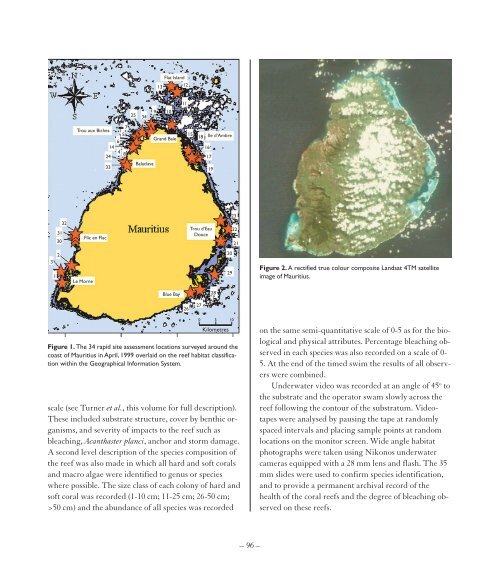You also want an ePaper? Increase the reach of your titles
YUMPU automatically turns print PDFs into web optimized ePapers that Google loves.
Flat Island<br />
13 12<br />
25 34<br />
9 10<br />
11<br />
7<br />
Trou aux Biches<br />
5<br />
6<br />
14<br />
4<br />
8<br />
24<br />
33<br />
Balaclava<br />
Grand Baie<br />
15<br />
18 Ile d’Ambre<br />
16<br />
17<br />
19<br />
23<br />
31<br />
30<br />
32<br />
Flic en Flac<br />
Trou d’Eau<br />
Douce<br />
22<br />
21<br />
2<br />
20<br />
3<br />
1<br />
Le Morne<br />
29<br />
Figure 2. A rectified true colour composite Landsat 4TM satellite<br />
image of Mauritius.<br />
Blue Bay<br />
28<br />
26<br />
27<br />
0 5 10<br />
Kilometres<br />
Figure 1. The 34 rapid site assessment locations surveyed around the<br />
coast of Mauritius in April, 1999 overlaid on the reef habitat classification<br />
within the Geographical Information System.<br />
scale (see Turner et al., this volume for full description).<br />
These included substrate structure, cover by benthic organisms,<br />
and severity of impacts to the reef such as<br />
bleaching, Acanthaster planci, anchor and storm damage.<br />
A second level description of the species composition of<br />
the reef was also made in which all hard and soft corals<br />
and macro algae were identified to genus or species<br />
where possible. The size class of each colony of hard and<br />
soft coral was recorded (1-10 cm; 11-25 cm; 26-50 cm;<br />
>50 cm) and the abundance of all species was recorded<br />
on the same semi-quantitative scale of 0-5 as for the biological<br />
and physical attributes. Percentage bleaching observed<br />
in each species was also recorded on a scale of 0-<br />
5. At the end of the timed swim the results of all observers<br />
were combined.<br />
Underwater video was recorded at an angle of 45 o to<br />
the substrate and the operator swam slowly across the<br />
reef following the contour of the substratum. Videotapes<br />
were analysed by pausing the tape at randomly<br />
spaced intervals and placing sample points at random<br />
locations on the monitor screen. Wide angle habitat<br />
photographs were taken using Nikonos underwater<br />
cameras equipped with a 28 mm lens and flash. The 35<br />
mm slides were used to confirm species identification,<br />
and to provide a permanent archival record of the<br />
health of the coral reefs and the degree of bleaching observed<br />
on these reefs.<br />
– 96 –


















